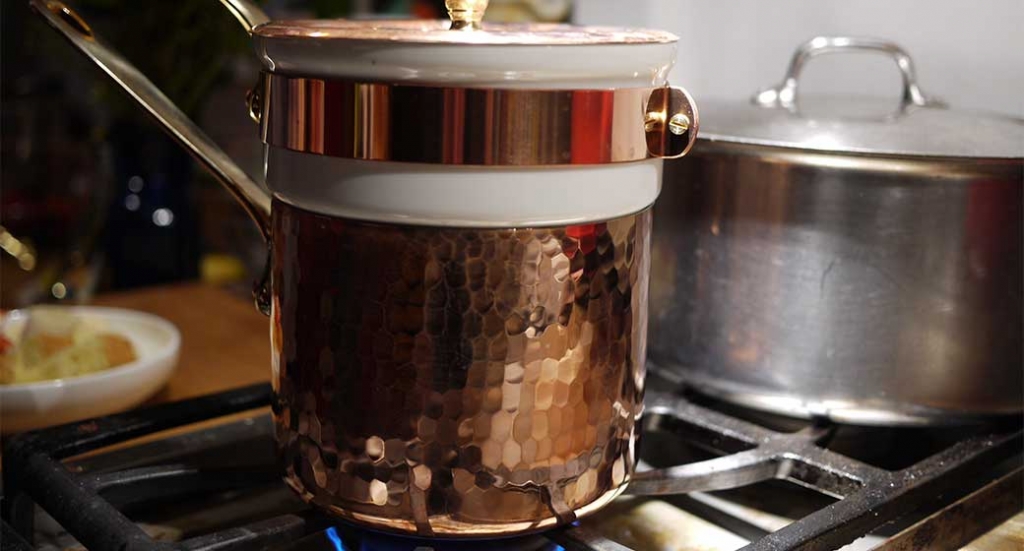The restaurant industry has a lot of obscure terms that often confuse even experienced chefs. One our favorite mystifying names also has one of the most interesting back-stories: the Bain Marie.
So let’s start with the basics: What is a bain marie? Simply put, it is very similar to the traditional double-boiler. It is also sometimes referred to as a water bath. Water is placed in one container and is heated. Another, smaller container is placed inside the first, heated by the water. In essence, it is a heated bath that can be used both to cook food and to keep food warm over time.
The term itself has become more loosely used to describe the type of pan used. So while its origins are focused on cooking and heating, modern bain maries are also commonly used to hold cold food items as well. In this situation, the hot water bath is replaced by a cooling unit or an ice bed.
Bain maries can come in any number of shapes and sizes. But in common restaurant uses, bain maries have evolved into some common forms. Most often, they are made from stainless steel. This is a good conductor of heat and easy to clean and maintain. They can be made of other materials such as ceramics, but these are not frequently used in a commercial setting.
The standard bain marie is round with a cylindrical shape, designed so that one pan can fit easily into another pan or into a water bath warming unit.

Uses for a Bain Marie

You’ve probably seen a bain marie even if you aren’t in the foodservice industry. They are common in many restaurants and have multiple applications.
When used for cooking, a bain marie is often used for delicate foods such as custards that are prone to crack using dry heat. Melting chocolate is another popular use for a bain marie.
Some chefs use a water bath method for cooking cheesecakes. Cheesecakes are in the custard family and can crack on the top when exposed to dry heat. By using a bain marie, the cheesecake can be cooked at a controlled temperature with moist heat.
However, cheesecakes are often cooked in springform pans. These types of pans are not one solid piece so leaking can occur. This can be minimized by using tinfoil to line the pan. But it is still a delicate process and a waterlogged cheesecake is still a risk.
The most common use for a modern bain marie is for food or ingredient holding. Bain maries are often used to keep foods cool as well as to heat them. This can be seen on salad bars that use bain maries for things like salad dressing. The container is placed in a cooling unit or surrounded by ice to keep foods fresh.
>> Shop for Bain Maries >>
The Notorious History of the Term Bain Marie

The words “bain marie” can be translated from the French as “Mary’s bath.” So who is Mary?
As it turns out, there actually was a Mary who lived somewhere between the 1st and 3rd centuries A.D.. Mary was known as “Mary the Jewess” and “Mary the Prophetess” and she was an early alchemist. Unfortunately, none of Mary’s writings survived directly. Almost all of what we know of her comes from the writings of others who mention her work and ideas.
But her name lives on in the form of her invention. The first mention comes in the form of medieval Latin with the term “balneum Mariae” which translates to Mary’s bath. This morphed into the French equivalent of “bain marie.” And it’s still in use today!
As an alchemist, Mary’s original invention looks much more like lab equipment than something you would find in a restaurant (see image at right). But it is the feature of using heated water to surround another container that provides the inspiration for what we now call a modern bain marie.
It’s very rare to be able to trace the origin of something like this all the way back to the 1st century A.D.. And it is even more remarkable that the name survived virtually in tact.
So the next time it’s slow in the kitchen, you will have this little nugget of trivia to entertain and amaze your co-workers. Tell them all about the alchemical origins of the humble bain marie!




Chocolate Raspberry Cheesecake ~ Now From Scratch
Crunchy Peanut butter Chocolate Caramel Bars - No-bake
The Alchemical Origins Of The Bain-Marie – Tasting Table - La Fabrique Du Chocolat
Rather geekish I would say.
14 Tips You Need To Bake The Perfect Cheesecake – dinnerideas
14 Tips You Need To Bake The Perfect Cheesecake - Dental Reviews and Tips
Do You Need A Water Bath When Making Cheesecake? – Mashed – Auto Robot Demo
nice information
this is a very good information of the bain marie